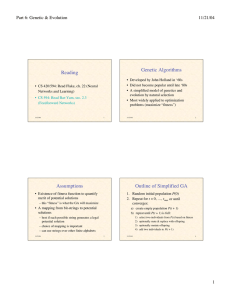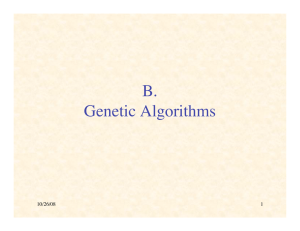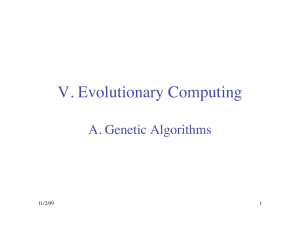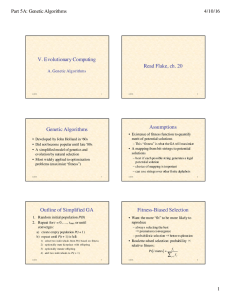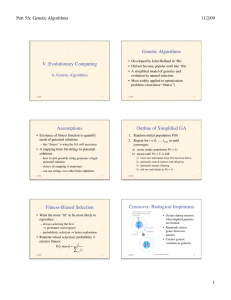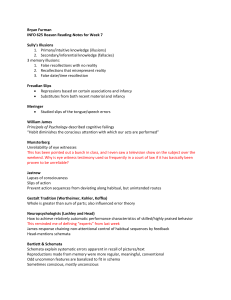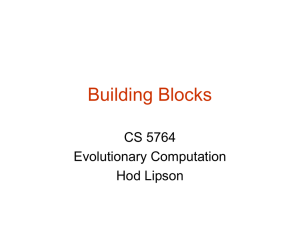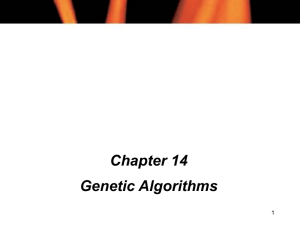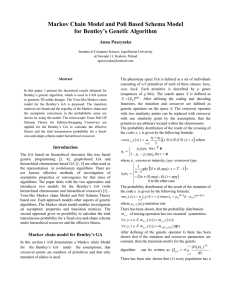Reading • CS 420/594: Read Flake, ch. 22 (Neural Networks and Learning)
advertisement
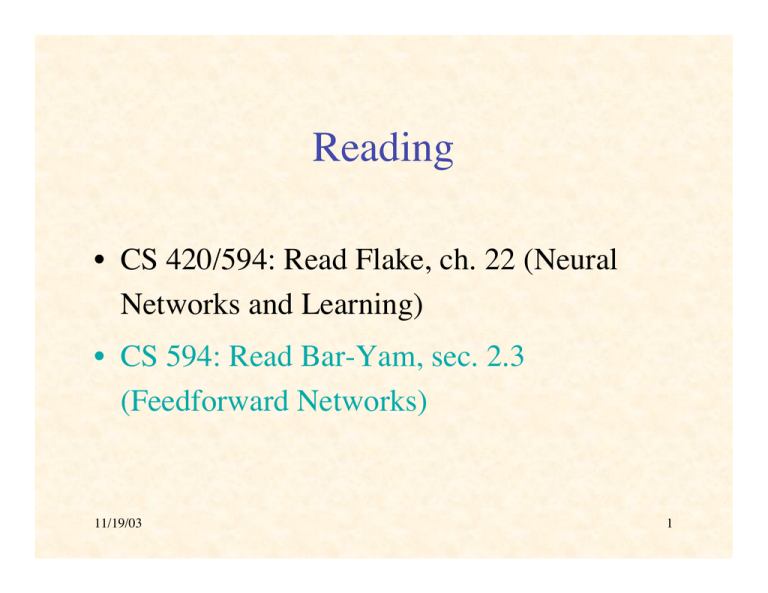
Reading
• CS 420/594: Read Flake, ch. 22 (Neural
Networks and Learning)
• CS 594: Read Bar-Yam, sec. 2.3
(Feedforward Networks)
11/19/03
1
Why Does the GA Work?
The Schema Theorem
11/19/03
2
Schemata
A schema is a description of certain patterns
of bits in a genetic string
...
110000
...
111010
a schema
110001
describes
many strings
11/19/03
*****0
**0*1*
11*0**
110*10
110010
110010
a string
belongs to
many schemata
3
The Fitness of Schemata
• The schemata are the building blocks of
solutions
• We would like to know the average fitness
of all possible strings belonging to a schema
• We cannot, but the strings in a population
that belong to a schema give an estimate of
the fitness of that schema
• Each string in a population is giving
information about all the schemata to which
it belongs (implicit parallelism)
11/19/03
4
Effect of Selection
Let n = size of population
Let m( S,t ) = number of instances of schema S at time t
†
†
†
String i gets picked with probability
Â
j
fj
Let f ( S ) = avg fitness of instances of S at time t
So expected m( S,t + 1) = m( S,t ) ⋅ n ⋅
†
Since f av =
†
fi
11/19/03
Â
j
n
fj
f ( S)
Â
j
fj
f ( S)
, m( S,t + 1) = m( S,t )
f av
5
Exponential Growth
• We have discovered:
m(S, t+1) = m(S, t) ⋅ f(S) / fav
• Suppose f(S) = fav (1 + c)
• Then m(S, t) = m(S, 0) (1 + c)t
• That is, exponential growth in aboveaverage schemata
11/19/03
6
Effect of Crossover
**1 … 0***
|¨dÆ|
• Let l = length of genetic strings
• Let d(S) = defining length of schema S
• Probability {crossover destroys S}:
pd = d(S) / (l – 1)
• Let pc = probability of crossover
• Probability schema survives:
d ( S)
ps ≥ 1- pc
l-1
11/19/03
7
Selection & Crossover Together
f (S) È
d (S ) ˘
m( S,t + 1) ≥ m( S,t )
Í1- pc
˙
f av Î
l -1˚
†
11/19/03
8
Effect of Mutation
• Let pm = probability of mutation
• So 1 – pm = probability an allele survives
• Let o(S) = number of fixed positions in S
• The probability they all survive is
(1 – pm)o(S)
• If pm << 1, (1 – pm)o(S) ≈ 1 – o(S) pm
11/19/03
9
Schema Theorem:
“Fundamental Theorem of GAs”
˘
f (S) È
d (S )
m( S,t + 1) ≥ m( S,t )
- o( S ) pm ˙
Í1- pc
f av Î
l -1
˚
†
11/19/03
10
The Bandit Problem
• Two-armed bandit:
– random payoffs with (unknown) means m1, m2
and variances s1, s2
– optimal strategy: allocate exponentially greater
number of trials to apparently better lever
• k-armed bandit: similar analysis applies
• Analogous to allocation of population to
schemata
• Suggests GA may allocate trials optimally
11/19/03
11
Goldberg’s Analysis of
Competent & Efficient GAs
11/19/03
12
Paradox of GAs
• Individually uninteresting operators:
– selection, recombination, mutation
• Selection + mutation fi continual
improvement
• Selection + recombination fi innovation
– generation vs.evaluation
• Fundamental intuition of GAs: the three
work well together
11/19/03
13
Race Between Selection &
Innovation: Takeover Time
• Takeover time t* = average time for most fit
to take over population
• Transaction selection: top 1/s replaced by s
copies
ß s quantifies selective pressure
• Estimate t* ≈ ln n / ln s
11/19/03
14
Innovation Time
• Innovation time ti = average time to get a
better individual through crossover &
mutation
• Let pi = probability a single crossover
produces a better individual
• Number of individuals undergoing
crossover = pc n
• Probability of improvement = pi pc n
• Estimate: ti ≈ 1 / (pc pi n)
11/19/03
15
Steady State Innovation
• Bad: t* < ti
– because once you have takeover, crossover
does no good
• Good: ti < t*
– because each time a better individual is
produced, the t* clock resets
– steady state innovation
• Innovation number:
t*
n ln n
Iv = = pc pi
>1
ti
ln s
11/19/03
16
Feasible Region
pc
successful
genetic algorithm
cross-competition
boundary
drift boundary
crossover probability
schema theorem boundary
mixing boundary
selection pressure
11/19/03
ln s
17
Other Algorithms Inspired by
Genetics and Evolution
• Evolutionary Programming
– natural representation, no crossover,time-varying
continuous mutation
• Evolutionary Strategies
– similar, but with a kind of recombination
• Genetic Programming
– like GA, but program trees instead of strings
• Classifier Systems
– GA + rules + bids/payments
• and many variants & combinations…
11/19/03
18
Additional Bibliography
1. Goldberg, D.E. The Design of Innovation:
Lessons from and for Competent Genetic
Algorithms. Kluwer, 2002.
2. Milner, R. The Encyclopedia of
Evolution. Facts on File, 1990.
11/19/03
19

